Discover the learning platform powered by collaborative learning.
A 15-minute discussion with an expert
100% tailored to your needs - with ❤️
No commitment. Free as can be.
Gen Z and millennials have declared career growth through continuous learning their #1 workplace priority. And L&D teams have taken the cue: 72% of employee training programs focused on skills development the following year.
If your training program is in the remaining 28%, your employees may be ready to leave for companies that have better career development paths. This makes it all the more imperative to engage and retain your teams with upskilling and career advancement opportunities in your company.
But launching a new training program isn’t as simple as designing a few courses with compulsory employee attendance. If you barrel forward without the proper planning, you’ll likely overwhelm your L&D department and still not meet employee expectations. That makes it tough to get company executive buy-in.
So take the time to create a democratic and collaborative learning process that benefits all stakeholders—because when everyone in the organization plays a part in the learning process, you'll see higher employee engagement and retention.

By providing your contact info, you agree to receive communications from 360Learning. You can opt-out at any time. For details, refer to our Privacy Policy.
A successful employee training program equips team members with valuable skills that support the company’s larger business goals. That means aiming for measurable results that reflect the specific skills the company needs.
Before launching your training program, first speak with management and company leadership. Find out the company’s short and long term priorities and set L&D goals that will help achieve those objectives.
For example, if a company’s current goal is to enter a new market, your new sales team training should focus on lead generation, rather than customer retention as a subject. Set up a system for identifying and prioritizing training needs that support these goals, and use those findings to drive course development.
Training is more than just investing in smarter employees. A well-deployed training program leads to a stronger, more competitive company.
Here are some ways to tie your training goals into larger company objectives:
1. Train for productivity and profit
Implement trainings that improve your sales team's skills. As a main driver of company revenue, this is a crucial area for L&D teams to focus on and prioritize. Programs that focus on sales development with specific training and constant coaching help teams close more deals. Sales coaching and sales enablement initiatives can help you measure the ROI of your training efforts with increased sales.
However, the impact of training on overall company productivity—a key factor in driving revenue—doesn’t end with sales. The benefits extend to every department in the company. According to HR Magazine, companies that invest at least $1,500 in training per employee see a 24% increase in profits compared to companies that don’t.
2. Enhance onboarding
The onboarding process directly influences your employees' first impression of your company. Good onboarding programs help new hires learn about the company and the skills they need to do their job. But that’s not all. It’s essential to form a healthy relationship between employee and employer in the first few months.
A robust onboarding program can boost new-hire retention by 50%, saving the company thousands in churn costs. Plus, a standardized onboarding program can increase new-hire productivity by 62%, which also boosts employee engagement.
3. Close the skills gap
As technology evolves, many companies struggle to keep up with the demands of digital transformation. They need skilled employees who can engage in continuous learning in order to keep pace. Upskilling programs that build on employees’ existing skills and reskilling programs that train employees in entirely new areas help you leverage your existing employees to meet digital age demands.
4. Hire and retain your best employees
L&D programs that include training in new areas are a huge draw for prospective employees seeking opportunities to learn and grow their skills. Just like Gen Z employees, millennial workers place great importance on growth opportunities when considering a new job. Likewise, employee development programs help retain valuable employees by supporting their growth and offering opportunities to expand their skillset within the organization. Here are 7 steps to create employee development plans that work - and fill critical skills gaps.
Before you create training programs that support the goals outlined above, you’ll need to identify any knowledge gaps in your company. The training needs analysis can be approached in two ways:
The first is a centralized process and takes a traditional top-down approach. L&D departments or training managers are the sole investigators and decision-makers on what employees need to learn. Managers use their understanding of employee knowledge gaps to prioritize learning needs and make course recommendations.
The downside to top-down analysis is that it typically involves a lot of guesswork, as managers try to assess what employees know and what they need to learn to do their jobs more effectively. Courses are created without team member input, meaning they often miss the mark on actual training needs.

The second method is a decentralized, bottom-up approach. With this system, employees tell their managers or the L&D department what their training needs are, and then L&D manages the system. Instead of using guesswork to dictate training needs, L&D teams can immediately prioritize employee's requested learning topics and organize their fulfillment.
This approach makes employees an active part of the training process. Bottom-up training needs analysis isn’t a one-off activity, but an ongoing process that evolves alongside the company and its employees. It’s faster, more efficient, and most importantly, more accurate than top-down approaches.
Read more:
You can’t tackle every training need at once. Attempting to do so can lead to team burnout and quickly deplete your training budget. Instead, prioritize training needs that help you accomplish the training goals laid out at the beginning of this process.
We recommend using the Boston Consulting Group’s Growth-Share Matrix to categorize training needs based on their cost and organizational impact.
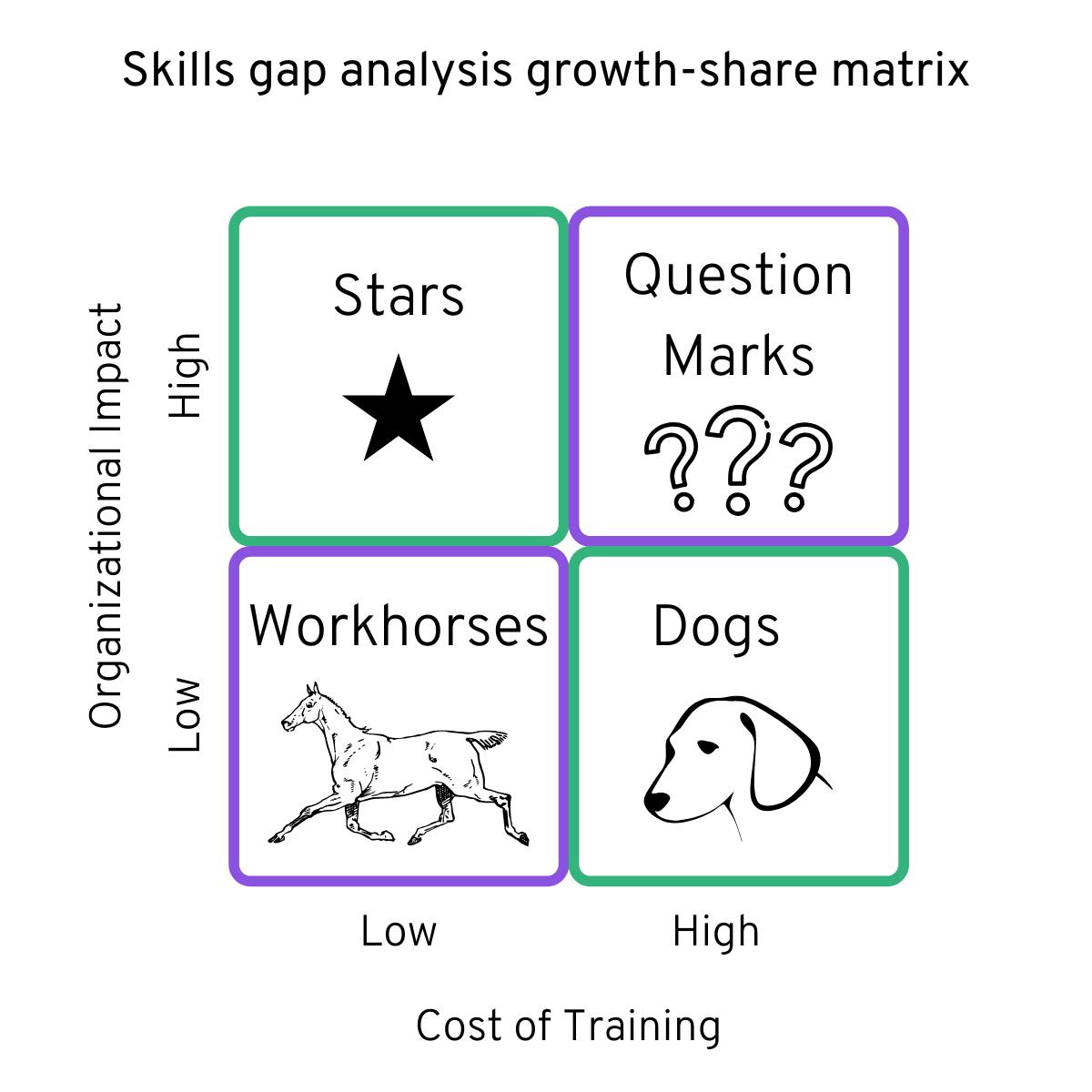
This will give you a roadmap for which training to tackle first. Prioritize “stars”: needs with the lowest cost, but the highest impact. Deprioritize expensive training that doesn’t immediately help you reach your organizational goals.
Identifying the best training style for your team's needs can be a challenge. Here are five popular employee training methods to consider:
In-person training refers to any method that requires the learners' physical presence. Activities include classroom-based training, seminars and workshops, hands-on training, and watching instructional videos or reading manuals on-site.
Typically, in-person training programs are more expensive and logistically challenging to organize. Businesses have to spend money on in-person trainers, physical training materials, and sometimes travel expenses and venue costs. They can be a scheduling nightmare as you need everyone to be available at the same time and in the same place.
And if employees are absent on training day, you’ll either need to reschedule, re-run the entire training, or risk your employees falling behind.
Over the past decade, a growing number of companies have gravitated from in-person to online training. The pandemic fast-tracked the move to a remote-first work environment, and organizations around the world have reaped the benefits of full online training. Traditional in-person instruction is largely restrictive compared to modern online training methods, which make it easier to learn anywhere, at any time.
Online employee training, sometimes called e-learning, takes place entirely over the internet. Online training can include online courses, simulations, webinars, mobile learning, and collaborative learning experiences.
A survey by Vyond found that 51% of employees prefer self-guided online training. That isn't surprising, given online training is much more flexible than in-person training, enabling employees to learn at their own pace and convenience. It creates an environment where learning becomes an integral part of daily life and company culture.
Blended learning, sometimes called hybrid learning, combines online training methods with in-person training. For in-person or hybrid companies, blended learning can be a bridge between legacy programs and 100% online learning. With so many teams working from home, companies are increasingly seeing the benefit of complementing face-to-face training with online learning.
A blended learning program can help L&D departments scale up their training efforts without spending money on more in-person training. For example, you can supplement an on-site seminar with an online webinar, or follow up an in-person training session with virtual practice sessions.
Many employee training programs have low course completion rates because the courses are too long. It’s hard for employees to commit an hour or more out of their busy day to training.
A solution to this problem is microlearning: short learning experiences that take no more than 10 minutes to complete. They present smaller, digestible chunks of material at a time, compared to a typical e-learning course that might take hours or days to complete.
Studies show that microlearning drives higher knowledge retention than traditional e-learning. Microlearning is also easier to produce than longer courses, and easier for employees to work into their daily life.
Peer training happens when employees collaborate to learn alongside and from one another. Peer learning, or collaborative learning, is a more active and engaging way to learn than solo learning. There are many different ways to incorporate peer training into your programs.
At 360Learning, we encourage a culture of peer learning by prioritizing training based on employees’ requests and empowering internal subject matter experts to share their knowledge across the organization.
Read more:
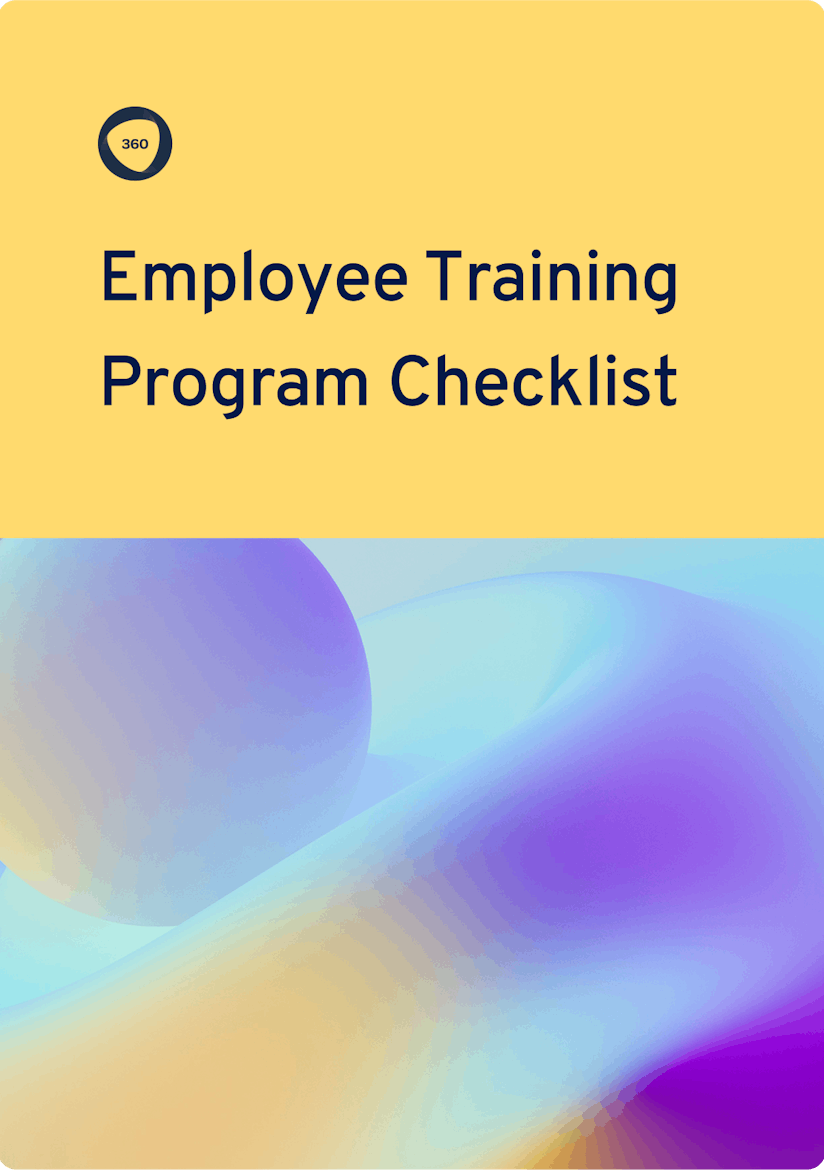
By providing your contact info, you agree to receive communications from 360Learning. You can opt-out at any time. For details, refer to our Privacy Policy.
If you decide to create an online learning program, you’ll need the right employee training software to support it. While there is a plethora of learning platforms on the market today, we recommend a collaborative learning system because it’s easier and faster to set up and maintain than a traditional learning management system (LMS).
Learning platforms are the software you use to create, distribute, and monitor online courses. Most tools bill themselves as learning management systems. While an LMS is the most popular type of learning platform, it has some serious drawbacks for modern L&D departments.
Traditional learning management systems silo the learning process because only admins can create and distribute courses. This also typically involves a lengthy and expensive course-creation process that requires special tools and experience to master.
Most importantly, traditional LMS systems are not designed to be employee-centric. Managers cannot set learning paths, employees can’t browse courses, and team members cannot work together to create learning content.
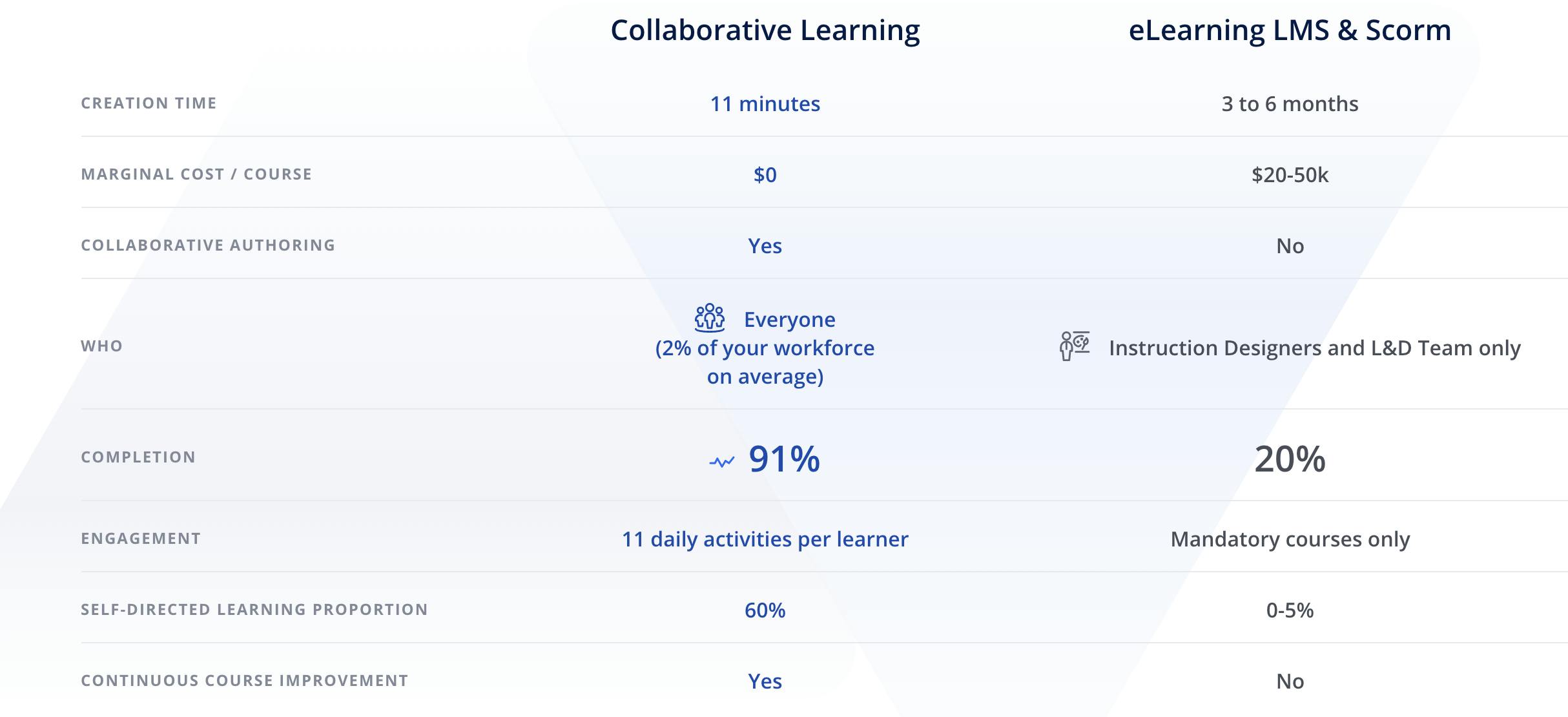
In contrast, a collaborative learning system encourages everyone in the company to play a part in the learning process. Collaborative editing features give you all the tools to easily create a course from scratch. Employees identify their training needs and make course requests. Internal subject matter experts create courses to meet those needs. L&D’s role is to prioritize learning needs and oversee course quality.
This democratic approach to course creation gets information to employees faster. It also allows for more feedback and easier editing, so courses are always relevant and up to date. Employees learn quicker and more efficiently. Engagement is higher, with collaborative course completion rates nearly 5x that of a traditional LMS.
Read more:
Not all training is the same. Each type of employee training has unique considerations and requirements. For each kind of training, you will need to adjust your training techniques to meet the needs of learners.
New employee training, or onboarding, encompasses all the training that new hires need to understand their role at the company, office culture, and tools for the job. This is every employee's first interaction with the company, so it’s essential that your onboarding process is smooth and helpful. Make the onboarding process collaborative, so new employees don’t just learn what’s expected of them, but they also feel like part of the team.
The onboarding process starts as soon as the candidate accepts the job. You can create a preboarding program or training manual to get them started before they arrive on their first day of work. Preboarding programs should make new hires feel welcome and give them an idea of what to expect on their first day.
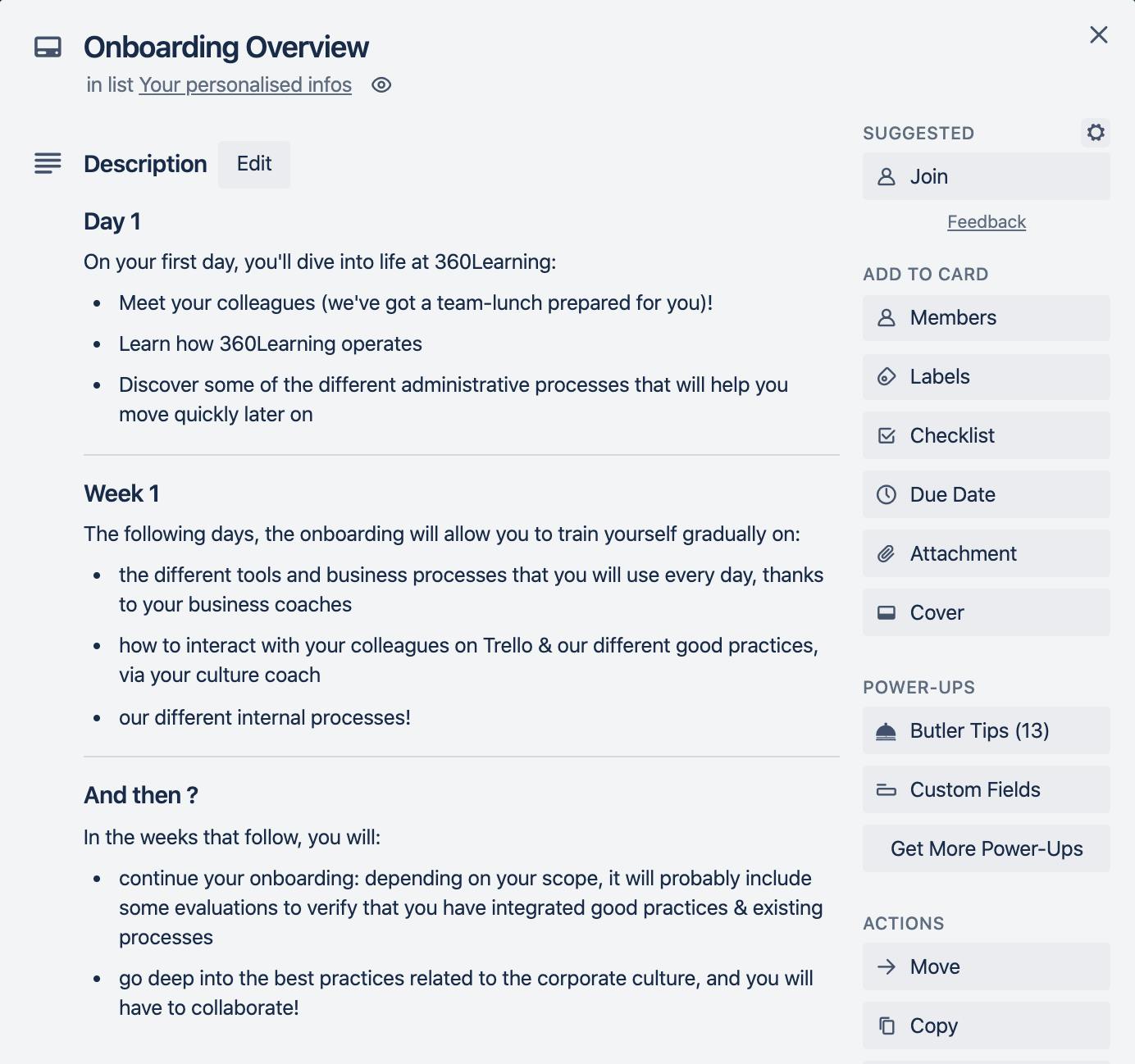
Tailor an employee’s onboarding training for their unique role in the company. Assign new hires an onboarding coach or buddy to guide them through their onboarding process and answer any questions. Create role-specific course tracks that help new hires acclimate themselves with the tools they need to do their jobs.
Throughout the process, ask new employees for feedback so that you can continue to perfect the onboarding experience for future employees.
Read more:
Compliance training is any training that is mandated by law, professional organizations, or the company itself. It encompasses everything from data safety and security, to anti-bias and diversity training. Compliance training is one of L&D’s most important yet least glamorous functions.
An effective solution to increasing course engagement and completion is making compliance training more interactive and impactful by incorporating different learning techniques. Keep employees interested with active learning techniques like quizzes, games, and simulations. And use employee voices to amplify the message of interpersonal training and peer learning.
Compliance training should always be kept up-to-date, so collect real-time employee feedback to improve the learning experience as you update course materials.
Read more:
Customer service training encompasses all the training that customer-facing employees need to represent the company comfortably and knowledgeably. This includes product familiarization, troubleshooting, conflict resolution, and communication skills.
Customer service reps need to be able to field user questions about new features and product updates. Collaborative learning through peer training and interactive learning are effective ways to disseminate institutional knowledge and boost learning retention.
Sales training, or sales enablement training, encompasses all the training that sales representatives need to effectively make and close deals. Great sales training has a direct effect on the company’s bottom line, and can be used to illustrate the ROI of your training programs.
Getting busy sales teams to take time out of their schedule to learn can be a challenge. Encourage continuous training with microlearning courses. These offer a quick and easy way for salespeople to regularly fit training into their busy days.
Here's an example of a tailored sales training course on a tool that helps our sales reps prove our platform's ROI to their prospective clients:
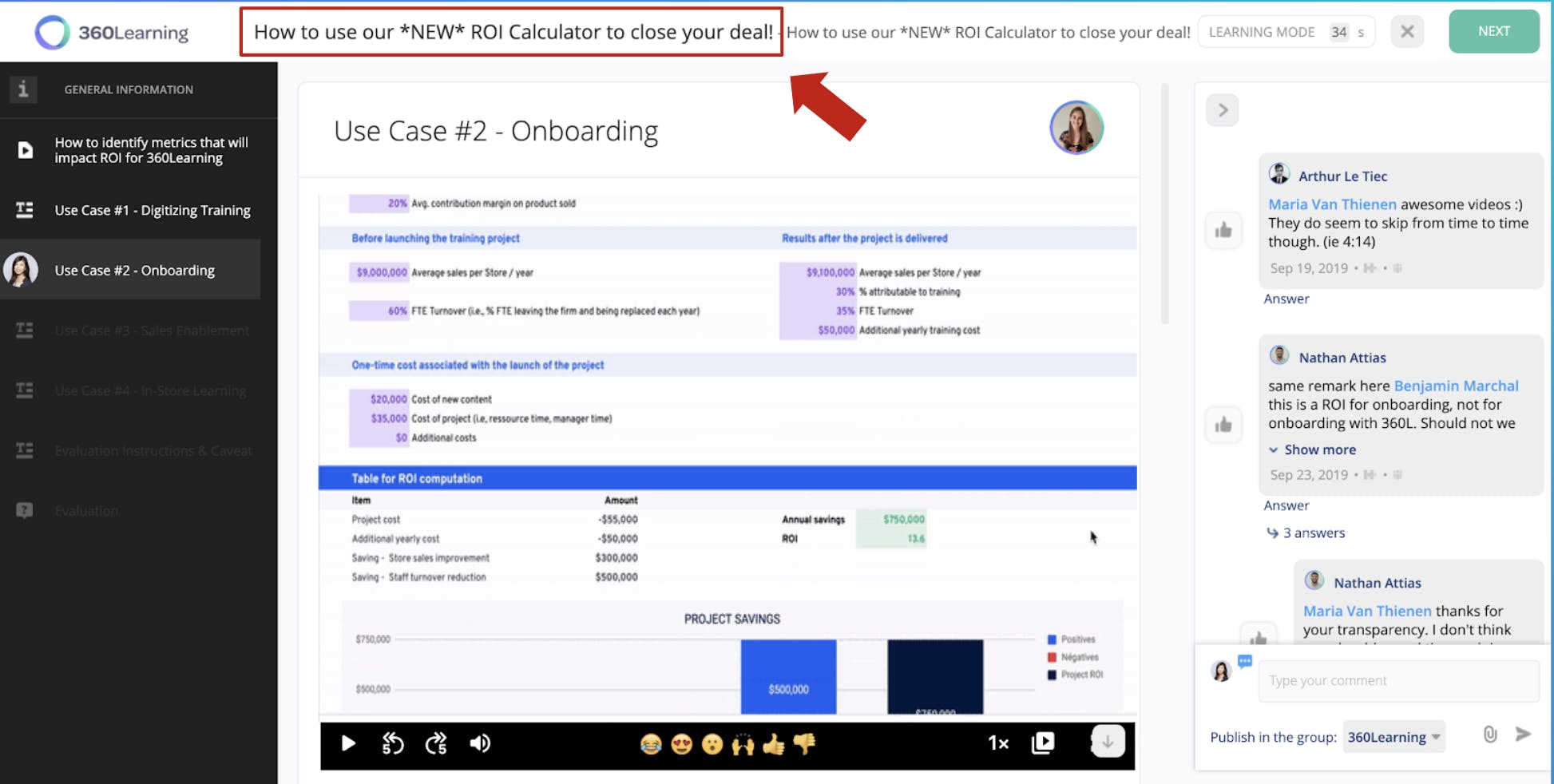
Anyone who manages other employees needs training to understand the nuances of leading their direct reports effectively. Managerial training is fundamental to creating more effective managers and better company culture for everyone. As an increasing number of companies work in globally distributed setups, it’s more important than ever for managers to hone their people management skills.
A major challenge of manager training is finding ways to teach the soft skills that make a successful supervisor: communication skills, bias training, conflict resolution, and goal setting. Remote managers in particular need impeccable communication and organization skills to keep their reports aligned.
A collaborative learning system is uniquely suited to train managers in these skills. Elements like role-playing, peer feedback, and hearing firsthand experiences from colleagues, help your managers learn to lead and work with diverse teams.
Read more:
Great training is just one aspect of L&D. You also need to measure the efficacy of those programs, collect feedback, and update course materials to make them as useful as possible. These follow-up tasks are crucial for securing bigger budgets and creating a continuous learning culture.
Many courses require frequent updates as training content becomes outdated quickly, especially in fast-evolving industries. Implement a process to quickly and easily revisit and update course content to ensure it’s always accurate and useful.
You should also collect metrics to measure engagement, program completion, and relevance scores to understand how employees interact with your courses. Analyzing this data helps identify courses that are due for an overhaul: whether it's because they're too difficult, too long to complete, or even if the content is simply uninteresting.
Collaborative learning platforms enable learners to can give feedback and make corrections to the course in real-time, so you can continually keep content up-to-date.
In 2022, the top focus for L&D professionals shifted to skills training. It’s vital to prove ROI of your training programs to justify your budget and secure executive buy-in and support.
To do this, you need to demonstrate the impact L&D initiatives have on supporting great business objectives. There are different methods to measure training ROI: both quantitative formulas and qualitative insights from anecdotal stories and experiences. You may want to use a mix of both to inform your learning and development strategy.
Read more:
Training works best when you have buy-in on every level, from the C-suite down to individual employees. Yet, in 2020 only 27% of L&D professionals said their CEOs were active champions of learning. Without C-suite support, it isn’t easy to grow your L&D department and secure the resources needed to develop robust learning initiatives.
A collaborative learning approach can help increase leadership buy-in with stronger L&D performance and concrete ROI metrics. Collaborative learning platforms enable your teams to ship courses quickly, boost engagement rates, and encourage peer involvement across the company. Show measurable impact of learning activities across the company, and you’ll win your leaders (and L&D budget!) over.
Looking for a surefire way to launch or revamp your employee training program? Our collaborative learning platform could be the answer. Book your personalized demo below.👇🏼
A 15-minute discussion with an expert
100% tailored to your needs - with ❤️
No commitment. Free as can be.
By providing your contact info, you agree to receive communications from 360Learning. You can opt-out at any time. For details, refer to our Privacy Policy.